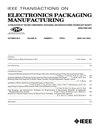Modified Face-Down Bonding of Ridge-Waveguide Lasers Using Hard Solder
IEEE Transactions on Electronics Packaging Manufacturing
Pub Date : 2008-03-31
DOI:10.1109/TEPM.2008.919329
引用次数: 9
Abstract
A modified face-down bonding technique of ridge-waveguide laser diodes (LDs) using 80Au20Sn solder has been performed. For ease of manufacturability, a bonding window with good bonding integrity and improved optical performance was determined. Metallographical investigation showed that the solder joint comprised of a layer of delta phase compound near the solder/heatsink interface, a layer of (Au,Ni)Sn intermetallic compound (IMC) at the solder/heatsink interface, and zeta' phase Au/Sn compound at the center of the solder joint. The delta phase shifted to the interfaces after reflow was postulated by its lower surface tension than zeta' phase Au/Sn compound. Good bonding integrity was observed with LD residues still adhering onto the bond pad after die shear testing. Scanning electron microscopy (SEM)/energy dispersive X-ray (EDX) analyses of the fracture surface showed that the fracture occurred within the LD, at the GaAs/SiN interface. LDs bonded with this modified bonding process achieved an optical improvement of 2.5-3X compared to the unbonded LDs due to its good thermal management. These bonded LDs further exhibited good long-term reliability with no significant degradation in optical performance and no significant microstructure evolution in the solder joint after 500 thermal cycling test.用硬焊料改进脊波导激光器的面向下键合
采用80Au20Sn焊料对脊波导激光二极管进行了面向下键合。为了便于制造,确定了具有良好粘合完整性和提高光学性能的粘合窗口。金相研究表明,该焊点由靠近焊料/散热器界面处的δ相化合物层、焊料/散热器界面处的(Au,Ni)Sn金属间化合物(IMC)层和焊点中心的zeta相Au/Sn化合物组成。由于δ相比zeta相Au/Sn化合物的表面张力更低,因此假定δ相在回流后向界面转移。通过模剪测试,观察到良好的粘结完整性,粘结垫上仍粘附有LD残留物。扫描电镜(SEM)和能量色散x射线(EDX)分析表明,断裂发生在LD内的GaAs/SiN界面处。由于其良好的热管理,与未粘合的ld相比,使用这种改进的粘合工艺粘合的ld的光学性能提高了2.5-3倍。经过500次热循环测试,这些结合的lcd显示出良好的长期可靠性,光学性能没有明显下降,焊点没有明显的微观结构变化。
本文章由计算机程序翻译,如有差异,请以英文原文为准。
求助全文
约1分钟内获得全文
求助全文

 求助内容:
求助内容: 应助结果提醒方式:
应助结果提醒方式:


